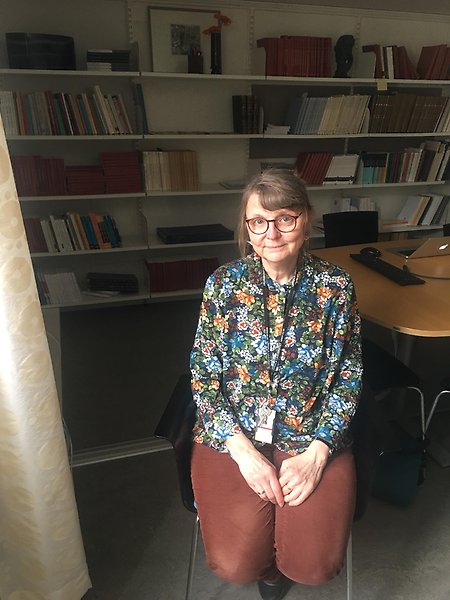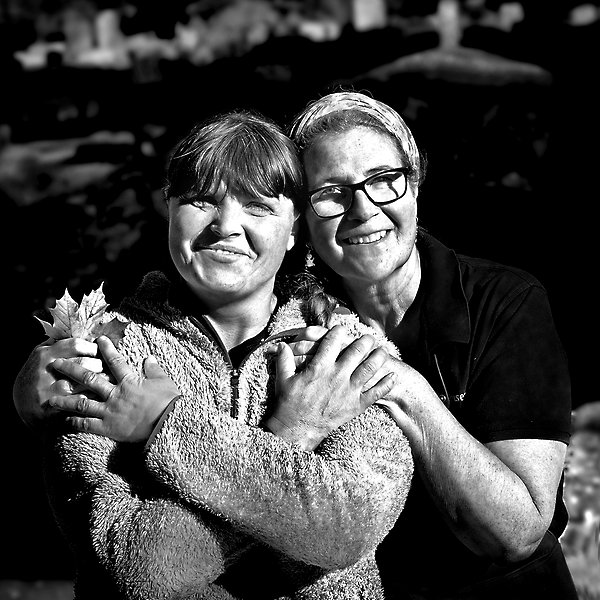Carina Johansson
Scrutinizing the power aspects of naming and depicting cultural heritage on Gotland

Carina Johansson.
Carina Johansson is a senior lecturer in ethnology at Campus Gotland. Her research has strong local roots on Gotland and combines previous experiences of working with photography and plants. Carina is also a frequent collaborator with stakeholders outside of the university.
-Right now I am working on a book project about female photographers on Gotland, from the 1860s to the present day. We are some people collaborating on the book by highlighting different aspects of the theme. My role as an ethnologist is to interview contemporary female photographers about their stories. We apply a gender perspective on photography as a profession, which connects to the history of technology and how society has been structured. For example, women have not always been allowed to come of age and run their own businesses.
Given Carina's previous research, this is not a surprising theme. Both photographs and Gotland are subjects that have recurred ever since her doctoral thesis Visby visuellt from 2009.
-I have been interested in photography for a long time and even considered working as a photographer. When I started working as an ethnologist instead, I realized that it is possible to use photographs as an ethnological tool when collecting material in different ways. In my doctoral thesis, I combined the research fields of visuality and cultural heritage by studying the image, and depictions, of Visby. Both the designation of cultural heritage and depictions contain power aspects that are important to scrutinize.
Carina points out that our digital age constantly showers us with different kinds of images.
-Earlier, a certain professional category dealt with images, now we all do it daily. I like to use two concepts from Art History: visual competence and observer power. Because we see so many images, we are good at categorizing them, but rarely discuss what images do to us and how they make us act. The research field of Visuality is about us humans as biological beings, in terms of how the eyes and the brain work. Moreover, it highlights that there are external forces that make us see in different ways. It is also important to study what we do not notice or take in.
The image of Visby
What was not seen, played a central role in Carina's dissertation.
-The town Visby on Gotland, which I wrote my thesis about, was a great place to use as an example. It is a place with a strong cultural heritage production, which has been depicted a lot for a long time. It was archaeologists, among others, who brought photography into the cultural heritage sphere; before that, cultural heritage was depicted with drawings or art images. There are tourist photos of Visby as far back as the 1860s. Therefore, there exist many different images of Visby, produced by various stakeholders. What I concluded in my thesis was that Gotland is so characterized by being a tourist destination. By constantly showing Visby in that way, the everyday lives of ordinary people, among other things, become hidden. My driving force is to nuance that image and create an understanding of what the strong tourist discourse does to Gotland as a place.
One consequence of the one-sided portrayal is that ordinary people are rendered invisible.
-It is a place where tourists come to live out their dreams without considering that there are already people living there. Tourists often take liberties that they would not do if they were more aware that there are many different kinds of people on Gotland.
Carina also believes that the tourist image of Visby does something to people's identities.
-Last fall, the photographer Tommy Söderlund and I worked on a project where we travelled around Gotland to meet people who live and work on the island. One couple we met did not think they were the right people to talk to. They did not see themselves as Gotlanders, even though they had lived and worked on Gotland for 30 years and their children grew up there. This is linked to the way the tourism industry has exoticized “original” Urgutar and the Gotland dialect. Not everyone speaks the dialect despite having lived on Gotland for generations.
The project was part of the Gotland Stories initiative by the Gotland Museum.
-Gotland Stories addresses the issues of the dominant tourist image. My and photographer Tommy Söderlund's contribution is called Fejs & Plejs, inspired by French filmmaker Agnes Warda and the artist JR's film Faces Places. The idea is to travel randomly to places and photograph the people you meet, and then exhibit their portraits in the same place. Tommy and I went to six different places on Gotland, all with different characters. For example, we photographed Eva who runs a café and has taken in several Ukrainian refugees on her farm. One of them is Lilja, who comes from Gammelsvenskby in Ukraine and has fled the war with her daughter. We finished the project in Bingeby, a part of Visby that is a bit stigmatized. In this way, we wanted to highlight an alternative image from the one usually shown of Gotland and Gotlanders.

Portrait of Lilja from Ukraine and Eva in Katthammarsvik, Gotland. Photographer: Tommy Söderlund.
Invisible cultural heritage
One consequence of the dominant tourist image is the formation of hierarchies between different cultural heritages. In Visby, the Middle Ages are so dominant that discussing other eras is difficult.
-For example, Gotland has several historical remains from the Second World War. There is a small war hospital museum in Lärbro that is run on a voluntary basis by the local history association. They tell an incredibly important story about World War II. When the Nazi concentration camps were liberated at the end of the war, Lärbro was one of the war hospitals to which white buses and boats took patients. German soldiers who had defected were also treated there. Many from the camps did not survive and were buried nearby. Some were Jews and some Catholics, from Greece, Italy, and Poland among others. This is so important to talk about and it is strange that it is so quiet around these sites.
Another cultural heritage rendered invisible is Visby's botanical garden.
-In the Hanseatic city of Visby, there is the DBW Botanical Garden from the 1850s. The garden contains several different types of cultural heritage, and you can see the different historical ideals. But it is from the wrong era to attract interest as part of the Hanseatic City of Visby World Heritage Site, on the UNESCO World Heritage List, even though it is within its boundaries. For me personally, the Botanical garden is a great way to combine research on cultural history with my interest in plants. I used to work as a florist but became allergic and had to retrain. That was how I got into ethnology at the age of 35.
Using ethnological perspectives
Two of the driving forces in ethnology at Campus Gotland have been Professors Owe Ronström and Ulf Palmenfelt.
-Owe and Ulf have always been very committed to collaborations, even after retirement. So when I came to Gotland, it was natural to follow that tradition. I have collaborated a lot with the cultural-historical Gotland Museum and have served on the museum's board. My focus on photography has also led to many synergies. I have been chairman of the association Gotland's photographic forum and together with them I have had events with the National Archives in Visby and made photo exhibitions at the Almedal Library, the Art Museum, and at the Folkets bio in connection with a film screening. I am also a member of Botan's friendship association and Gotland County's Handcraft Association.
Why is collaboration important to you?
-Ethnologists can contribute with important perspectives to archives, museums, and associations. Even if we do not always call it that, we work a lot with sustainability issues from social and cultural perspectives. The ethnological and humanistic contributions are important in these times when the societal view often is focused on economic terms. Even if each time and place is unique, ethnology can contribute by showing how things were in the past or are elsewhere, for example in terms of culture and migration. In this way, we can nuance the political messages of the populist forces that are growing in society. It is also important to remember that we should not just glorify history. The history of ethnology and folkloristics is not always something to be proud of, and that should not be hidden, Carina concludes.
Text: Jennie Sjödin, year 2023
